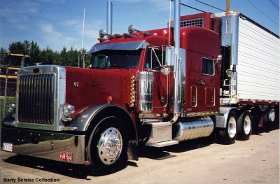I Suck At Double Clutching.
Topic 5326 | Page 1
Robert, it is very common, especially if you are accustomed to driving a standard shift automobile. The rhythm takes a little practice, but you will be good enough in a few short days to pass your driving test.

Im having the same problem. and the training I have been getting is without a clutch at all which is fine except you cant pass a test that way

So it was my first day of DC, and I'm descent at upshifting but I mess up a lot downshifting. I get it right sometimes. Is it common to have difficulty in this area? It feels so unnatural without synchro's.
Not sure what "DC" stands for, assuming you're trying to say that you've only had one day so far with double clutching and that you don't have it down yet, right? Well, you're just like probably 99% of most people who just start out! Nobody "gets it" on their first day man! Give yourself a break. Depending on the tractor, I still can overshoot my rpms when revving up to downshift, or not rev up enough and miss the gear. It's going to take practice. By the time you get your CDL , you'll still be practicing to make it more smooth. Don't worry about it.
CDL:
Commercial Driver's License (CDL)
A CDL is required to drive any of the following vehicles:
- Any combination of vehicles with a gross combined weight rating (GCWR) of 26,001 or more pounds, providing the gross vehicle weight rating (GVWR) of the vehicle being towed is in excess of 10,000 pounds.
- Any single vehicle with a GVWR of 26,001 or more pounds, or any such vehicle towing another not in excess of 10,000 pounds.
- Any vehicle, regardless of size, designed to transport 16 or more persons, including the driver.
- Any vehicle required by federal regulations to be placarded while transporting hazardous materials.
Double Clutch:
To engage and then disengage the clutch twice for every gear change.
When double clutching you will push in the clutch, take the gearshift out of gear, release the clutch, press the clutch in again, shift the gearshift into the next gear, then release the clutch.
This is done on standard transmissions which do not have synchronizers in them, like those found in almost all Class A trucks.
Double Clutching:
To engage and then disengage the clutch twice for every gear change.
When double clutching you will push in the clutch, take the gearshift out of gear, release the clutch, press the clutch in again, shift the gearshift into the next gear, then release the clutch.
This is done on standard transmissions which do not have synchronizers in them, like those found in almost all Class A trucks.

Im having the same problem. and the training I have been getting is without a clutch at all which is fine except you cant pass a test that way
If you're going to a school, I'm shocked somebody is teaching you to float gears right away. You're right, you need to double clutch to pass your exams. Why is your instructor not teaching you how to double clutch? Learning to float gears comes after, and even then, most companies don't want you to do it. It's kind of an unspoken thing ... companies don't want you to do it, most drivers do it anyhow because it can be easier than double clutching , plus less wear on the knee.
Float Gears:
An expression used to describe someone who is shifting gears without using the clutch at all. Drivers are taught to "Double Clutch" or press and release the clutch twice for each gear shift. If you're floating gears it means you're simply shifting without using the clutch at all.
Double Clutch:
To engage and then disengage the clutch twice for every gear change.
When double clutching you will push in the clutch, take the gearshift out of gear, release the clutch, press the clutch in again, shift the gearshift into the next gear, then release the clutch.
This is done on standard transmissions which do not have synchronizers in them, like those found in almost all Class A trucks.
Double Clutching:
To engage and then disengage the clutch twice for every gear change.
When double clutching you will push in the clutch, take the gearshift out of gear, release the clutch, press the clutch in again, shift the gearshift into the next gear, then release the clutch.
This is done on standard transmissions which do not have synchronizers in them, like those found in almost all Class A trucks.

Unfortunately im not in school for it.I have veteran drivers teaching me

Unfortunately im not in school for it.I have veteran drivers teaching me
Have you told them you need to learn how to double clutch then? Or don't they remember how to?
On another note, I'm not on the forum as much anymore, so I don't recognize you, but are you aware that most companies require you to have a verifiable amount of hours from a trucking school? Perhaps you're going right into a mom & pop outfit, but if you're looking at any of the mega carriers, getting your CDL on your own can put you in a predicament where you're not going to be hire-able. Just thought I'd throw that out there to make sure you're aware of it - again, not knowing your situation, I want to make sure you don't make a costly mistake.
CDL:
Commercial Driver's License (CDL)
A CDL is required to drive any of the following vehicles:
- Any combination of vehicles with a gross combined weight rating (GCWR) of 26,001 or more pounds, providing the gross vehicle weight rating (GVWR) of the vehicle being towed is in excess of 10,000 pounds.
- Any single vehicle with a GVWR of 26,001 or more pounds, or any such vehicle towing another not in excess of 10,000 pounds.
- Any vehicle, regardless of size, designed to transport 16 or more persons, including the driver.
- Any vehicle required by federal regulations to be placarded while transporting hazardous materials.
Double Clutch:
To engage and then disengage the clutch twice for every gear change.
When double clutching you will push in the clutch, take the gearshift out of gear, release the clutch, press the clutch in again, shift the gearshift into the next gear, then release the clutch.
This is done on standard transmissions which do not have synchronizers in them, like those found in almost all Class A trucks.
OWI:
Operating While Intoxicated

Unfortunately im not in school for it.I have veteran drivers teaching me
Have you told them you need to learn how to double clutch then? Or don't they remember how to?
On another note, I'm not on the forum as much anymore, so I don't recognize you, but are you aware that most companies require you to have a verifiable amount of hours from a trucking school? Perhaps you're going right into a mom & pop outfit, but if you're looking at any of the mega carriers, getting your CDL on your own can put you in a predicament where you're not going to be hire-able. Just thought I'd throw that out there to make sure you're aware of it - again, not knowing your situation, I want to make sure you don't make a costly mistake.
No, it's not like that at all. I've got a pre-hire with a few companies. What I care most about is safety and being able to drive the transmission the way it's meant. No I don't have crappy instructors. They are testing me on double clutching , NOT floating. And I finally got it down today. The thing you have to know about downshifting is this:
-Slow down to about 1100-1200 rpm. -Clutch to neutral and then rev up about 15-1600 rpm -Clutch to gear. (for example, 5 to 4) -Below 4, don't bother downshifting, there is enought torque for acceleration if need-be.
But yeah, I was making the mistake of being in like 1500 rpm then downshifts. That means about 2000 rpm for the next lowest gear. Not ideal to be so high in such a high rpm range -you're just making things more difficult than you should be.
CDL:
Commercial Driver's License (CDL)
A CDL is required to drive any of the following vehicles:
- Any combination of vehicles with a gross combined weight rating (GCWR) of 26,001 or more pounds, providing the gross vehicle weight rating (GVWR) of the vehicle being towed is in excess of 10,000 pounds.
- Any single vehicle with a GVWR of 26,001 or more pounds, or any such vehicle towing another not in excess of 10,000 pounds.
- Any vehicle, regardless of size, designed to transport 16 or more persons, including the driver.
- Any vehicle required by federal regulations to be placarded while transporting hazardous materials.
Double Clutch:
To engage and then disengage the clutch twice for every gear change.
When double clutching you will push in the clutch, take the gearshift out of gear, release the clutch, press the clutch in again, shift the gearshift into the next gear, then release the clutch.
This is done on standard transmissions which do not have synchronizers in them, like those found in almost all Class A trucks.
Double Clutching:
To engage and then disengage the clutch twice for every gear change.
When double clutching you will push in the clutch, take the gearshift out of gear, release the clutch, press the clutch in again, shift the gearshift into the next gear, then release the clutch.
This is done on standard transmissions which do not have synchronizers in them, like those found in almost all Class A trucks.
Pre-hire:
What Exactly Is A Pre-Hire Letter?
Pre-hire letters are acceptance letters from trucking companies to students, or even potential students, to verify placement. The trucking companies are saying in writing that the student, or potential student, appears to meet the company's minimum hiring requirements and is welcome to attend their orientation at the company’s expense once he or she graduates from truck driving school and has their CDL in hand.
We have an excellent article that will help you Understand The Pre-Hire Process.
A Pre-Hire Letter Is Not A Guarantee Of Employment
The people that receive a pre-hire letter are people who meet the company's minimum hiring requirements, but it is not an employment contract. It is an invitation to orientation, and the orientation itself is a prerequisite to employment.
During the orientation you will get a physical, drug screen, and background check done. These and other qualifications must be met before someone in orientation is officially hired.
OWI:
Operating While Intoxicated

I'm in training still.. I'm a total noob when it comes to what kind of truck I'm driving. But I'm top of my class with shifting. Where I can't back the best I make up for great upshifting and downshifting. I take pride in that since I've never touched a manual transmission in my life!!!
Its an Eaton Fuller 10 speed... Upshifting is great. Don't overthink it, keep the rpm's in the green sweet spot. clutch, neutral, clutch shift!
Downshifting can be crazy. Especially on those exit ramps that are super short. I downshift to 9th around 55mph, slow down to 35 then downshift to 8th, slow down to 25 and downshift to 7th, slowdown to 15ish and hit 6th gear.
1-5 is alien to me... we're not allowed to use those gears yet.
Of course I'm training with a college that uses an empty trailer!!! so I hope I can still shift like this when I get a job.
The rule the instructor told us to follow was... if your going 25mph.. add 2+5 and you get 7.. so get to 7th gear. If you're going 35mph.. add 3+5 and you get 8.. so you go to 8th gear LOL anything below 25 you're ready for 6th.
Hope I don't get anyone too upset. I know how experienced folk can become when they see the student doing stuff like this. One day I'll be shifting without looking at my tachometer and floating the gears!
HOS:
Hours Of Service
HOS refers to the logbook hours of service regulations.
Richard, thats called gear matching and its invaluable when downshifting. Miss a shift? No problem, how fast are you going, match that gear. Also, on a 10 speed, the lower gears are 3,5,7,9 and 11 mph (1,2,3,4,5). One thing that is helping me remember where all those gears are is, on the high side, even gears on the bottom row ( 6,8,10) odd on the top ( 7,9 ) low side is reversed. Odd on the bottom( 1,3,5) even on the top( 2,4)
HOS:
Hours Of Service
HOS refers to the logbook hours of service regulations.New Reply:
New! Check out our help videos for a better understanding of our forum features

















Preview:
This topic has the following tags:
Getting Your CDL Hard Lessons Learned High Road Training Program Tips For Shifting Truck Equipment







 TT On Facebook
TT On Facebook
So it was my first day of DC, and I'm descent at upshifting but I mess up a lot downshifting. I get it right sometimes. Is it common to have difficulty in this area? It feels so unnatural without synchro's.